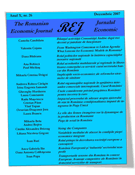Abstract:
It has become a common claim that the gravest dangers to world security are no longer military threats from rival great powers, but rather transnational threats emanating from poorly governed countries.Since the end of the Cold War, the international community has become increasingly preoccupied with the phenomenon usually named “state failure”, because state failure causes a wide range of humanitarian, legal, and security problems.Recent examples of failed states are familiar to all of us, from the total collapse of state institutions in Somalia and the disintegration of the former Yugoslavia to the varied crises in Rwanda, Haiti, Liberia, Congo, Sierra Leone, and Afghanistan. But how can we measure or define if a state is a“weak” or a “failed”state?Due to the importance gained by this issue, several international organizations(World Bank, The Fund for Peace) and national institutions (U.S. National Security and the Commission on Weak States, United Kingdom’s Department for International Development) performed several surveys in this respect. This paper aims to identify and to analyze the ways to measure state failure and concludes with commentaries drawn on a contrasting perspective of three most renowned attempts (e.g. the Transformational Index of the Bertelsmann Foundation, the Governance Index of the World Bank, and the Failed States Index of the Foreign Policy Council).
